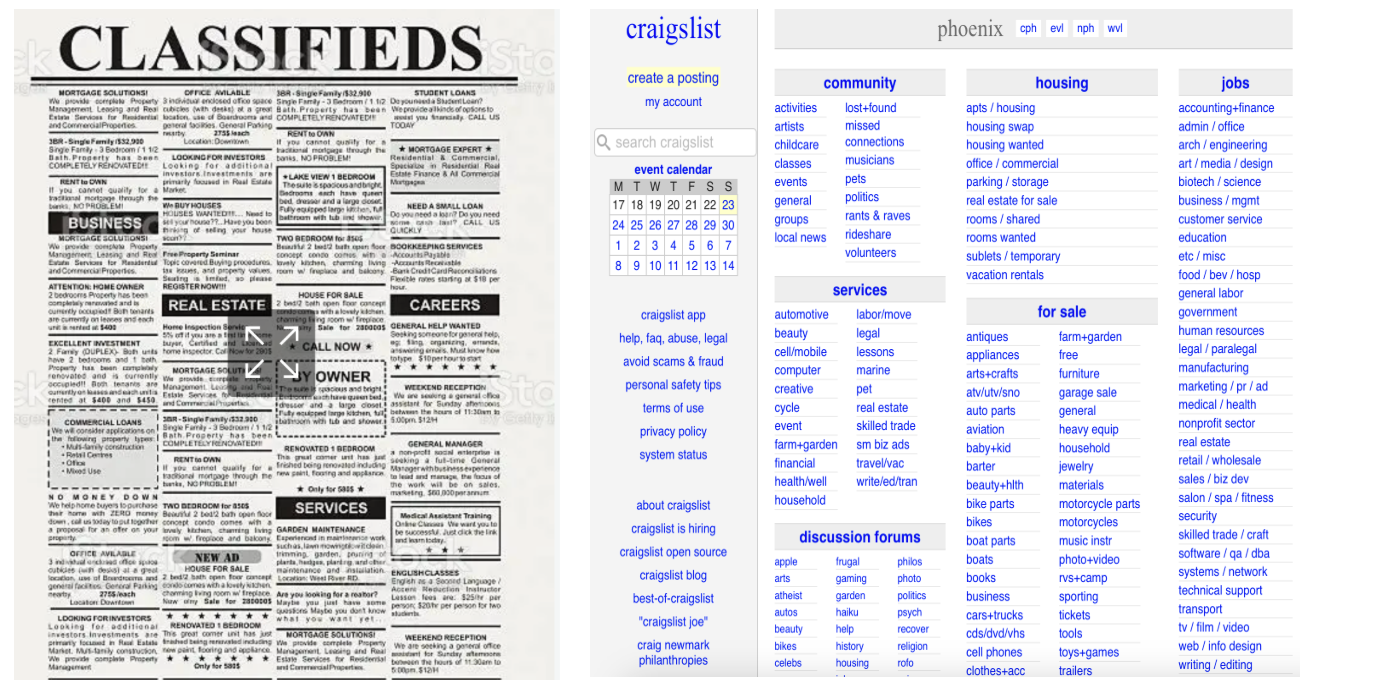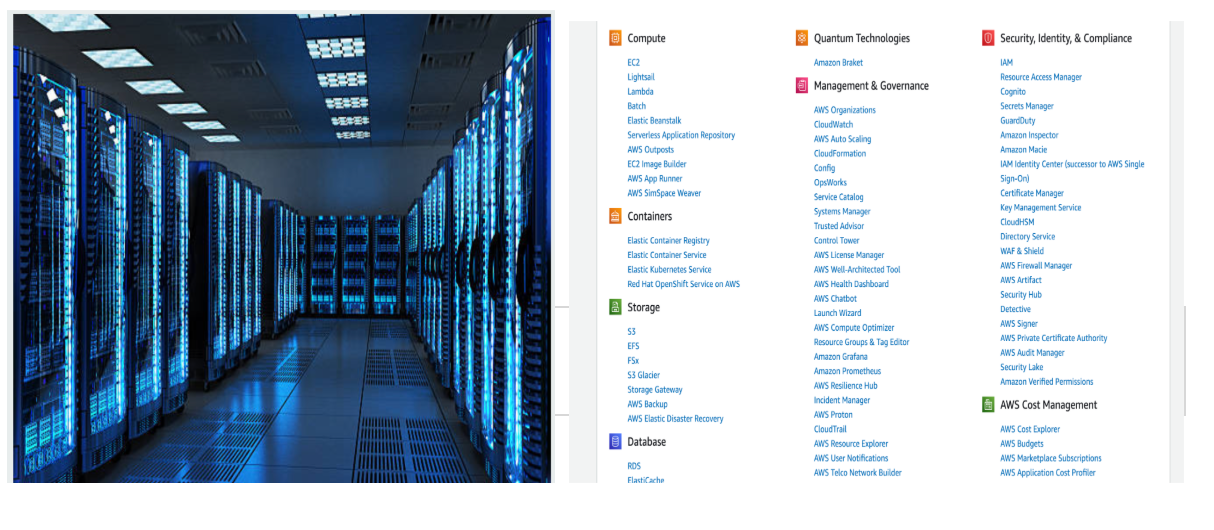The term unbundling was introduced in this article, The Great Unbundling, by A16Z. It’s now a few years old and was targeted at consumer applications, but the key idea applies to other platforms, specifically cloud platforms. The crux of the idea presented is that very broad platforms reach a tipping point at which they start splitting into verticals. Examples shown are well validated with Airbnb, etc, as proven ones and TikTok as emerging trends that have since continued to prove the thesis. As presented in the article, similar to the Craigslist example, cloud providers are ripe for unbundling, and in fact, it's already happening. Just as you could look at Craiglist and areas of the main page became entire companies in their own right, a look at a major cloud provider, e.g. AWS, will also show emerging companies that are already being built that specialize and build upon a core AWS service.
Examples of the trend
Some broad buckets are listed from more mature to less mature and emerging. This post talks about some of these as well.
- PaaS (Platform as a Service) - I am biased since I’ve spent the most time in this layer, first on the team building an internal platform at Stripe and now at Render. But this is also the most obvious layer because it’s the natural workflow developers need. They provide a combination of tools that developers need in a single space - typically compute, data, and the developer workflow, but this layer is growing to absorb more complexity and has also led to all the conversations around Platform Engineering (enough material for a hopefully future post).
- Managed Data and Databases - This space has seen a huge amount of growth in the last decade, and there are a lot of solutions in this space that have validated this theory, e.g., Redshift, Mongo, but also many emerging solutions.
- As data is such a broad space, we are starting to see tools emerging in specialized areas, e.g. tools for Data Scientists(Hex) as well as Machine Learning platforms
- Observability - NewRelic, Datadog, Honeycomb.io, and a plethora of others
- Developer Productivity - DevX, LinearB, Swarmia
- Security - Snyk, Sysdig, Semgrep
- Compliance -Vanta, Secureframe, Drata
- Privacy- Evervault
- Operations (Pagerduty, Incident.io, Kintaba) - This category is potentially the most interesting, in my opinion, because while Pagerduty has existed for a while, it only scratched the surface of what is possible, and many of the new startups are doing very interesting work in this area, and the reduction of undifferentiated toil is the true value add of software that will only be accelerated with AI. You can also argue that many others started out under the broader bucket of operations, e.g., compliance, developer productivity, etc.
Note - This is not an exhaustive list but just examples to illustrate each trend. I have probably forgotten some obvious ones. I did not cover AI because it is extremely broad and rapidly changing so anything here will likely be immediately out of date.
A trend that can be observed in the solutions that matured sooner as standalone solutions is software platforms first (compute, data) followed by operations. Another way to look at the same trend is to look at large cloud-native SaaS companies and the clusters their internal teams are formed around, as well as the internal software many of them need to build and operate. You can start to see patterns emerging, and entire companies start to build generalized software that sometimes starts as internal software built for a growing startup.
The list of examples I categorized above also roughly maps to an organization I was a part of at Stripe, which was the internal Infrastructure team known as Foundation, but many companies of the same era had similar organizational patterns.
Lift and shift followed by abstractions.
There was a separate pattern in the Craigslist example that the post doesn’t explicitly call out where we can see a parallel to cloud providers
Craigslist, in many ways, was the first step in the digitization of newspaper classifieds. It was a pure lift and shift in many ways or an example of “software eating the world.” Once things were moved online, the second step was unbundling. In fact, Craigslist today is famously unchanged and looks very similar to newspaper classifieds that it was moving online.

Similar to the newspaper classifieds to Craigslist, in the 2000s, virtualization, and hardware advances enabled the mass movement of physical data centers online. This accomplished the first step of digitization.
Side note: I was at VMware during the emergence of the cloud and it was disheartening to watch them fail to capitalize on the technology they had modernized and popularized.
- Virtualization moved physical data centers to the cloud. But in many cases the underlying complexity was unchanged. It was a huge leap forward but still incomplete.
- Cloud platforms bundled up physical resources and served them in a single platform for users. However, what developers want isn’t pure resources. This led to the wave of DevOps, where it was recognized that what developers needed was workflows, not just a cluster of resources.
- This is another occurrence of the pattern of productionizing of operations - in this case, for developers.
The key to building in this layer is to offer targeted workflows and a superior user experience (this mirrors the original a16z post where specialization leads to unbundling). So, niching down vs generalizing. User experience focused on specific users and workflows vs just offering up a collection of resources. Developers, data scientists, ML engineers, etc, are just resources for everyone. Abstractions for specific users are the key. Many billion dollar companies are being built and will continue to be built from the list of services shown on the right.

But what about?
Some obvious criticisms of this thesis and the emerging companies that we hear a lot of
- "It’s just a wrapper"- The same was said of Retool, Heroku, Vercel, Render, and many others, and has been proved incorrect many times. Good wrappers, i.e., good abstractions, provide a real value. Hiding complexity and operationalizing undifferentiated toil unlocks meaningful gains. Seen note below on Dropbox [1].
- "Cloud providers will build it" - This can conceivably be said of many startups declared unicorns in the last decade, including Dropbox, Stripe, etc. But cloud providers have a nuge market in selling their current services and aren't hugely motivated to build up the stack. This is the classic innovator's dilemma but less fatal for cloud providers because many of these emerging companies are building on top of a cloud provider, so they are symbiotic vs competitive to them. In fact, in many cases, they create entirely new markets for cloud providers that wouldn't otherwise exist.
To summarize, a pattern we see in software cycles:
- Software eats chunks of the physical world to create platforms.
- As specializations and use cases of these platform emerge, they get unbundled into verticals.
- Typically, resources are the first to be productionized with their underlying workflows, followed by operations.
- Good abstractions provide real, meaningful value and are a fertile source of innovation.
- Cloud providers and the operations required to operate services on them are a huge area for emerging startups.
Notes
[1] Dropbox is an interesting example because it doesn't fit cleanly with this model even though it's first launch was famously derided on HackerNews. They started on AWS but then led a long migration to their own datacenters. It's a bit of a distraction from my core thesis and probably needs it's own longer post so I'm removing it from key examples.